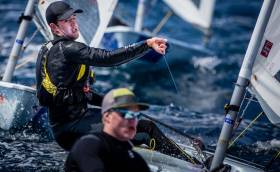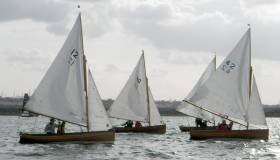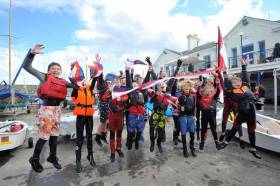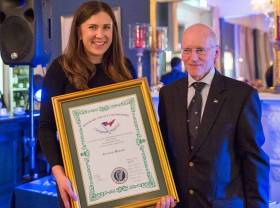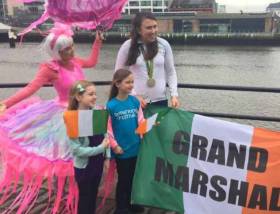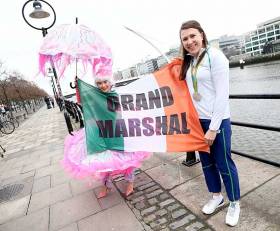Displaying items by tag: Annalise Murphy
Annalise Murphy Fitness: A Typical Day Video
As Annalise Murphy prepares her campaign for Gold at Tokyo 2020, the National Yacht Club Olympic Silver Medalist has shared a 'day in her life video' training around Dublin Bay.
Three hours on the water with boat handling, speed testing and race practice and video analysis, she follows it with a 63–km endurance bike ride in the afternoon. See video below.
A blustery westerly breeze made for challenging conditions today at Hyères for Finn Lynch in the men's Laser fleet yesterday writes Nathaniel Ogden. A mixed set of results seem to be becoming a theme in this year's Sailing World Cup for the National Yacht Club sailor. Three strong finishes, coming in 7th, 10th and 13th from the 60–strong fleet, were again unfortunately overshadowed by some poorer finishes and a BFD. As racing continues today, and the live medal races begin, an overall mid fleet position will be an important result for Ireland's youngest ever Olympic sailor as he continues his Tokyo 2020 campaign.
Aisling Keller slipped down the Laser Radial fleet slightly yesterday, coming in 35th overall as stronger westerly winds in the mid twenties dominated day four at Hyères. Producing another solid set of results during the day, coming in the mid-twenties in 3 races, the young Lough Derg sailors overall result was brought down slightly by two poorer finishes at the start of the day and a BFD in the final race (discarded), ending up 41st.
Howth Yacht Club’s Aoife Hopkins climbed the rankings after racing on day four, ending up in 41st position. Heavier conditions proved to deliver a mixed set of results for the young sailor, who is currently taking time out of studying for the Leaving Certificate to compete at Hyères. She ended the day with an outstanding 8th place finish in the final race and is in 39th place.
So overall, FInn lies 35th, Aoife 39th, Aisling 41st. The Lasers and Radials still have two races to sail today. Overall results to date are here
In the 49erfx, Irish interest lies with Royal Irish's Saskia Tidey and Charlotte Dobson who maintained their 3rd place medal position, as the wind picked up on day four of the Sailing World Cup in Hyères, as a westerly breeze of 22-27 knots, with gusts of 30-35 knots, settled in yesterday morning. The pair will go on to represent Britain in the 49erFX fleet today and Sunday in the live medal races.
Sailors are always thrilled when they have a return of straight race victories. Then there are times when they are happy to come out in one piece, still within touching distance of the medals.
That was the case today at Sailing's World Cup Series in Hyères, France as chaos reigned in the Laser Radial fleet.
The competition in Hyères reached a critical stage on Friday with Medal Races imminent.
Overnight, the forecast for racing on Friday was not looking good and Hyères was expected to be on the receiving end of 30knots of breeze, gusting 35. The breeze was strong in the morning and sailing postponed as the conditions were not deemed safe enough to sail. As the day progressed the breeze decreased enabling all but one fleet, the 2.4 Norlin OD, to hit the water.
The Laser Radial saw a day of chaos but Evi van Acker (BEL) has been there and done it. Van Acker was beaming with a smile ashore after racing following a sixth and 13th place to take the lead.
Explaining the day van Acker said, "We waited a couple of hours because it was too windy, then we got out there and it wasn't windy at all. Then it was shifty. We were far out today between fighting winds coming from the left, then the right, so today you didn't know where you were.”
It was probably making sense of the chaos that brought the smile to van Acker's face, "When we were racing there were very big variations in wind and strength so you were winning, then in the middle.
"It was crazy, but I did ok.
"I had some pretty good results in some very tough conditions.”
Van Acker is 12 points clear of Tuula Tenkanen (FIN).
Overnight leader, Hungary's Maria Erdi, crept over the start line for her second black flag of the regatta and has fallen to ninth.
If van Acker was confused, then so was the young Hungarian, "I didn't push the line. I mean I didn't know what was happening at the start. Wind was shifting. People at the pin end. Wind turned. I just didn't know what was happening.”
Carrying two maximum scores in a one discard regatta effectively puts you out of the running, so what now for Erdi, "If I make the top ten I am happy. That was my goal before the regatta started and it's still my goal.”
Italy's Francesco Marrai took the shifty conditions in his stride with a bullet and fourth place to move him top above Cypriot Pavlos Kontides.
Great Britain's Nick Thompson is now tied with Kontides with an impressive second and third place. Those scores were impressive as second placed Kontides and fourth placed Matt Wearn (AUS) both had high scores on the day which they had to discard.
With another day of qualification racing before Sunday's live Medal Race, the top order in the fleet could yet again switch around as a competitive Laser fleet continue to battle.
It was a day of contrasts in the Men's and Women's 470. Blows were exchanged between the leaders in the women's and the men's saw some knock outs.
Still on the same points total, Afrodite Zegers and Annaloes van Veen (NED) and Linda Fahrni and Maja Siegenthaler (SUI) both notched up a bullet and second place to ensure that the Hyères title goes right down to the wire. With one more day of racing before the Medal Race, you wouldn't bet against these two going in to a double points decider neck and neck.
With a perfect two bullet day, Rio 2016 silver medallist's Mat Belcher and Will Ryan now have a 19-point buffer over second placed Carl -Fredrik Fock and Marcus Dackhammar (SWE).
Overnight leaders, Panagiotis Mantis and Pavlos Kagialis have dropped after a 21-22 day which they have to carry. They now sit on 54 compared to the Australians 14 and the reason was simple, "We had really bad starts today,” said a despondent Mantis, "We also missed the first shift and when you do both of those you are in trouble. It was such a bad day.”
The Greeks will have to recover their composure quickly and return to winning ways just to stay in contention for medals after an impressive opening three days of racing.
What a day Spain's Diego Botin and Iago Marra had in the 49er. Coming in the day the Spaniards were in medal contention. At the end of the day they had guaranteed themselves a gold medal. With a bullet, sixth and 11th, Botin and Marra have an unassailable 27 point lead ahead of the Medal Race.
Great Britain's Dylan Fletcher-Scott and Stu Bithell and Sweden's Carl Sylvan and Marcus Anjemark are tied on 76 points and will fight it out with Yago and Klaus Lange, on 83 points, for silver and bronze.
Fast becoming a regular sentence in a 49erFX day review, Brazil's Martine Grael and Kahena Kunze are in first place. Looking to add yet another gold to their ever growing collection, the Rio 2016 Olympic champions hold pole position for a Hyères win with an eight point lead over nearest rivals Victoria Jurczok and Anika Lorenz (GER).
There were some big climbers in the RS:X fleets shaking things up before Saturday's live Medal Race.
France's Louis Giard now sits top of the men's fleet after a 1-4-5 scoreline which gives him a one point advantage over the man who has occupied pole position all week, Switzerland's Mateo Sanz Lanz. The Swiss windsurfer could only card a 9-14-8 which are all scores he carries.
Winner of the first World Cup Series event in Miami, USA, Yunxiu Lu (CHN) was head and shoulders above the Women's RS:X fleet, claiming a bullet and two seconds. She leapfrogs several rivals into second. With a 19-point lead, Poland's Zofia Noceti-Klepacka remains top going into the double points Medal Race.
Fernando Echavarri and Tara Pacheco (ESP) hold a seven-point advantage over their nearest rivals, France's Moana Vaireaux and Manon Audinet in the Nacra 17. The Spanish pair finished the qualifying series with a bullet which made up for a discarded tenth place in the previous race. Add to that a second place and it was enough to lift them above the French team who scored 11-2-5.
On day three, Turkey's Alican Kaynar thought the then leader Nicholas Heiner (NED) had sailed conservative to take the lead. Well Kaynar was anything but as he took two bullets to take top spot from the Dutch sailor's grasp.
Damien Seguin (FRA) remains on course to win a seventh Hyères title in the 2.4 Norlin OD. The Frenchman was somewhat lucky however, that the fleet only raced once as he was back onshore fixing a mechanical issue on his boat while his competitors were out racing. Spain's Rafa Andarias claimed the only bullet on offer to lift himself in to fourth position. Two races will bring the 2.4 Norlin OD fleet to a close on Saturday
French friends and rivals, Nicolas Parlier and Axel Mazella continue to lead the way in the Formula Foiling Kiteboarding. Parlier has the upper hand with five wins from six races which gives him a four-point lead over Mazella. It was day of mixed fortunes for Mazella, but still good enough to give him a 22-point cushion over third placed Toni Vodisek (SLO)
Racing continues on Saturday 29 April at 11:00 local time with the first day of Live Medal Races shown on the World Sailing YouTube Channel. Sunday 30 April will be the second day of Live Medal Races and will bring the penultimate event before the Santander Final to a close.
Live Medal Races will be shown on the World Sailing YouTube Channel on Saturday 29 and Sunday 30 April, bringing the penultimate event before the Santander Final to a close.
Dun Laoghaire endured strong northerly winds for several days over the past week, so, there was a fear that many Water Wag owners would give the first race a miss. However, on 26th April, eighteen Water Wags competed in the first race for The Newsom Memorial Cup including Rio Olympic Silver medalist Annalise Murphy.
The wind was still coming from the north, blowing at about 7 knots, so, the race committee under Tom Hudson, laid a windward-leeward course with the windward mark located in the harbour mouth. At the start, only the Water Wags in the front line had enough wind to power away. As the fleet split with most boats heading towards the west, Cathy MacAleavey’s Mariposa new Water Wag, only launched last week led the fleet. At the windward mark the order was Mariposa, Moosmie and Pansy which had taken the eastern side of the course. On the offwind leg, there was much blanketing from the fleet behind, and there was an even split between boats taking each of the leeward gate marks.
By the second windward mark David MacFarlane’s Moosmie was in the lead, with the Kilroys in Swift in second and Mariposa in third place. This order remained until the end of the third beat, at which time the wind had dropped to 4 knots, and the race committee decided to shorted the race. David and Patricia Corcoran in Peggy in 7th place were top competitors racing for The Hilpotsteiner Tankard in Division IB, with Fergus Cullen and Alice Walshe in Penelope one place behind.
Leading boat of Division 2 racing for the Phyllis Cup was Freddie sailed by Bairbre Stewart with new crew, Benno MacCormack who helped her to finish high up the fleet. Second in Division 2 was mother and daughter team of Kate and Amy O’Leary in Chloe. Next Wednesday the Water Wags will compete in the second leg of a series of three matches.
1st – 15, Moosmie, David MacFarland.
2nd - 38, Swift, Guy and Jackie Kilroy.
3rd. - 45, Mariposa, Cathy MacAleavey and Con Murphy
4th. - 41, Mollie, Annalise Murphy.
5th 42, Tortoise, William Prentice.
6th. 3, Pansy, Vincent Delany and Niamh Hooper.
7th. 47, Peggy, David and Patricia Corcoran.
8th. 16, Penelope,
9th. 43, Freddie
10th. 8, Barbara
11th. 34, Chloe
12th. 30, Sara
13th. 46, Mademoiselle
14th. 33, Eva
15th. 40, Swallow
16th, 44, Scallywag
17th. 10, Sprite
18th 31. Polly.
National Yacht Club Junior Sailors Celebrate Links to Olympic Silver Medal & America’s Cup
A very special Golden Jubilee coming up in May provides links to an Irish Olympic Sailing Silver Medal, the Fireball World Championship, and the America’s Cup. W M Nixon finds the widest connections go even further than that to include a pioneering world voyage.
It was in May 1967 that the irrepressible Carmel Winkelmann oversaw the first results of a junior sailing initiative at the National Yacht Cub, her home club in Dun Laoghaire. It became a movement which went on which to have nationwide and worldwide ramifications, so much so that within Ireland we’re looking at an unbroken line in Irish sailing which is continued through the club which currently holds the title of ISA Training Centre of the Year, which for 2017 is Foynes Yacht Club on the Shannon Estuary.
That a successful club at the heart of the Atlantic seaboard can trace an almost magic thread back to something which happened at a club on Dublin Bay a long time ago is quite a story in itself. Particularly when the Atlantic seaboard club itself is imbued, as Foynes is, with the spirit of legendary circumnavigator Conor O’Brien. However, when the story is shaping up to continue with the Golden Jubilee as the latest chapter, it gives us an opportunity both to celebrate, and take stock of what it has all meant.
 Foynes Yacht Club, heirs to an Irish tradition of junior sail training which was first formalized by the National Yacht Club 50 years ago. At the Irish Sailing Awards ceremony when Foynes were announced as winners of the ISA Training Centre of the Year Award were (left to right) Simon McGibney (Foynes Senior Instructor), Sailor of the year and Olympic Silver Medallist Annalise Murphy of the National Yacht Club, Elaine O’Mahoney (Foynes Sailing Academy Manager), Pat Finucane (Sailing Academy Principal) and Conor Dillon (Instructor). In a club which is imbued with the spirit of world-girdling Foynes sailor Conor O’Brien, it’s particularly appropriate that Conor Dillon’s sailing CV includes winning the Two-Handed division in the Round Ireland Race, sailing with his father Derek Dillon on a 34-footer. Photo: Inpho
Foynes Yacht Club, heirs to an Irish tradition of junior sail training which was first formalized by the National Yacht Club 50 years ago. At the Irish Sailing Awards ceremony when Foynes were announced as winners of the ISA Training Centre of the Year Award were (left to right) Simon McGibney (Foynes Senior Instructor), Sailor of the year and Olympic Silver Medallist Annalise Murphy of the National Yacht Club, Elaine O’Mahoney (Foynes Sailing Academy Manager), Pat Finucane (Sailing Academy Principal) and Conor Dillon (Instructor). In a club which is imbued with the spirit of world-girdling Foynes sailor Conor O’Brien, it’s particularly appropriate that Conor Dillon’s sailing CV includes winning the Two-Handed division in the Round Ireland Race, sailing with his father Derek Dillon on a 34-footer. Photo: Inpho
But business first. Anyone who has ever taken part in the Junior Training Programme at the National Yacht Club is hereby alerted – if you don’t know already – that on the evening and night of Saturday May 20th, there will be a very special celebration at the clubhouse. The organisers Carmel Winkelmann and Ann Kirwan are particularly keen to trace those who have moved away, but would find much nostalgic pleasure with the meeting of old friends by returning on this day of days. So if that applies to you, or you know anyone to whom it does, please make contact with the key club administrator whom everyone refers to as “Oonagh at the National”, the proper line of contact being [email protected], tel 01-280 5725.
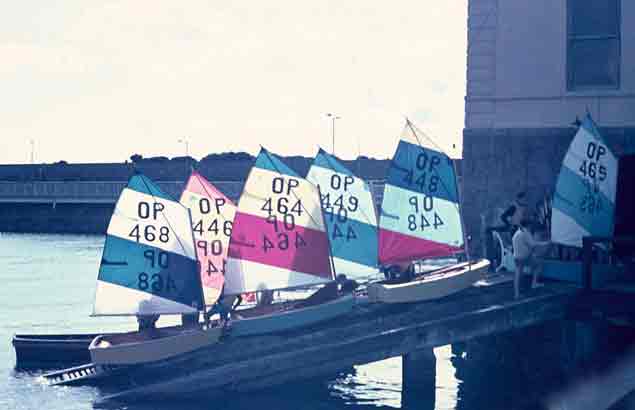 Bright morning of Optimism. The National Yacht Club slipway in 1967, long before the days of an extensive front-of-club platform, with the new dinghies of the Optimist Class being launched out of the cramped boathouse under the club, and down a steep and often very crowded slipway
Bright morning of Optimism. The National Yacht Club slipway in 1967, long before the days of an extensive front-of-club platform, with the new dinghies of the Optimist Class being launched out of the cramped boathouse under the club, and down a steep and often very crowded slipway
To grasp the significance of what is being celebrated, please try to visualize the National Yacht Club as it was fifty years ago. The building itself, standing directly in the harbour, has the air of a fishing lodge in the West of Ireland on its seaward side, and a hint of neo-classicism when seen from the town. But in the early 1960s it was very limited in its shoreside facilites for sailing dinghies. There was a boathouse entered through fine granite arches under the clubhouse itself, but to use it, masts needed to be lowered. It was served by a very steep and easily-crowded slip, while there was access to another slip on the east side of the cub which served a small area where dinghies could be stored. But while there was space for the established classes of Fireflies and some IDRA 14s, some room was also needed for the small tenders for larger yachts moored in the harbour, while the racing keelboats were served by club launches which might be substantial dinghies driven by vintage Seagull outboards.
The concept of a proper dinghy park was still only in its infancy, relatively speaking, for craft such as Dun Laoghaire’s Firefly and IDRA fleets which had been active since the late 1940s. Thus if anyone had a centreboard boat which could reasonably be expected to lie to moorings, she was obliged to do so, and the fleet of small craft lying off the club included the 17ft Mermaids and the 14ft Water Wags.
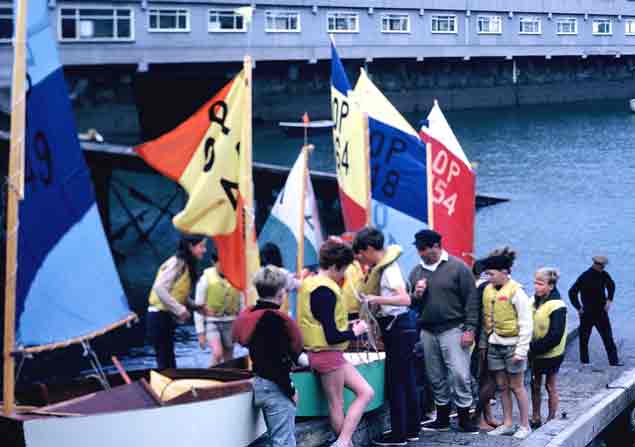 It could get very crowded on that steep slipway. Paddy Kirwan at the centre of a group making do with limited facilities
It could get very crowded on that steep slipway. Paddy Kirwan at the centre of a group making do with limited facilities
To compound the space problems afloat and ashore, during the 1960s the area in the southeast part of Dun Laoghaire Harbour off the National Yacht Club was the focal point for the cross-channel ferry berths. The railway-system serving Mailboat with its emphasis on foot passengers continued to use the Carlisle Pier to the west of the club, but the East Pier was known for a period as the Car Ferry Pier as a busy new roll-on roll-off terminal, which admittedly always had a temporary look about it, had been constructed there to accommodate the new trend in cross-channel travel.
Thus not only was anyone sailing a dinghy from shore at the National YC dong so out of decidedly limited facilities, but they immediately sailed into an area cluttered with a collection of moored boats of all shapes and sizes, and that in turn was set in an area which might have ferry ships berthed close by, or manoeuvring on either side.
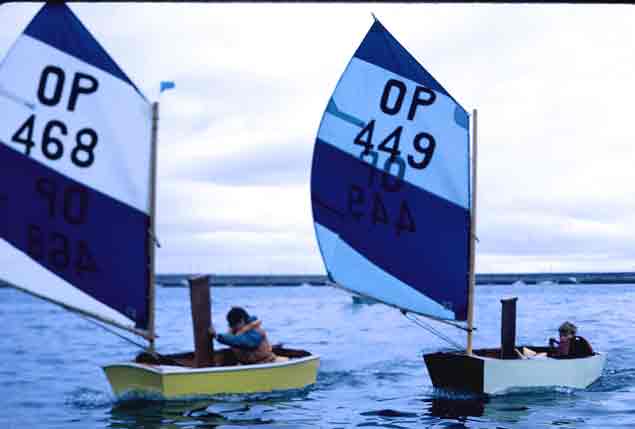 Learning curve. Gina Duffy and John Lavery on a close run in 1967. The latter has won many major championships, including the Fireball Worlds in 1995
Learning curve. Gina Duffy and John Lavery on a close run in 1967. The latter has won many major championships, including the Fireball Worlds in 1995
The comparisons with today’s National Yacht Club with its spacious platform facing out over a much clearer harbour area, and beside it an installation of convenient berthing pontoons, could not be greater. But back in the 1960s, an equally important change was happening – there was a complete re-appraisal of what the most junior sailors really needed in boats and instruction to get the best from the sport.
For sure there were the Fireflies, but in terms of lower age limit they were really aimed at adolescents on the cusp of rapidly growing youth. The other available classes were even more adult-oriented. In fact, the underlying problem was that children going sailing were treated as miniature adults who would somehow pick up the skills of the game through a sort of osmosis, whereas for a crucial period of their lives they would have most benefitted from being treated as a different species, with different boats to meet their needs.
Yet even here, adult views dominated. The grown-ups thought that young people’s boats should at least look like small yachts. Thus a dinghy which was promoted for children by several clubs was the 11ft Yachting World Cartop Heron, which had originally been conceived as a DIY-build which could fit on the roof-rack of the average family car, and was designed with a gunter rig such that all its spars could be stowed within the boat.
It had some good ideas, and with a pretty sheer it fulfilled the adult expectation of what a miniature yacht should look like. But it was surprisingly heavy for its avowed rooftop requirement – you’d have needed a weight-trained family to get it on the car roof. And anyway, it was too large for really small kids who genuinely had the sailing bug.
 The southeast corner of Dun Laoghaire Harbour was very different in 1967, with the East Pier re-designated as the Car Ferry Pier. Yet despite the limitations, the Optimist class quickly caught on after its introduction in 1967
The southeast corner of Dun Laoghaire Harbour was very different in 1967, with the East Pier re-designated as the Car Ferry Pier. Yet despite the limitations, the Optimist class quickly caught on after its introduction in 1967
So a revolutionary approach was needed, and it came thanks to one of the National YC’s international sailing stars, Johnny Hooper. He had achieved Ireland’s first Olympic Race win with Peter Gray in the Flying Dutchman in the 1960 Rome Olympics when the sailing was at Naples. But as an FD campaign towards the 1984 Olympics was prohibitively expensive with the venue in Japan, he returned to his first love of International 505 Racing, and it was at a big 505 championship in Scandinavia in 1965 or thereabouts that he first became aware of the game-changing possibilities of the Optimist for junior sailing.
Scandinavia being rightly renowned for the elegance of its yacht, it speaks volume for the versatility of the Florida-originating Optimist, the “simple little boxboat that sails surprisingly well”, that Scandinavia should lead the movement towards a world body for a boat which, whatever the traditionalists might think, the kids were clearly loving. Founded 1965, the International Optimist Dinghy Association (IODA) had Viggo Jacobsen of Denmark as its first President with his wife Edith as Secretary, and in that same year Johnny Hooper set about introducing the idea of the Optimist to Ireland.
Now if some ordinary Joe had happened to by impressed by an Optimist at some foreign location, and had even brought one home to persuade his fellow sailors that they were looking at the future, the idea probably would have fallen very flat indeed.
But that’s not the Hooper way. Instead, from his highly respected position he quietly targeted fellow National Yacht Club members who were themselves active sailors, but also had children who would benefit from the Optimist experience, and in time a group emerged which was to include initially Johnny Hooper with his wife Bernie giving the longterm involvement, Peter Gray, Paddy & Barbara Kirwan , Don Douglas, Franz & Carmel Winkelmann, Michael McGrath, Arthur Lavery and several others, many of whom had reasonable DIY skills and could see the possibility of building an Optimist in the basement of their Dun Laoghaire homes without too much disruption of the household. By the Autumn of 1966, the project was under way.
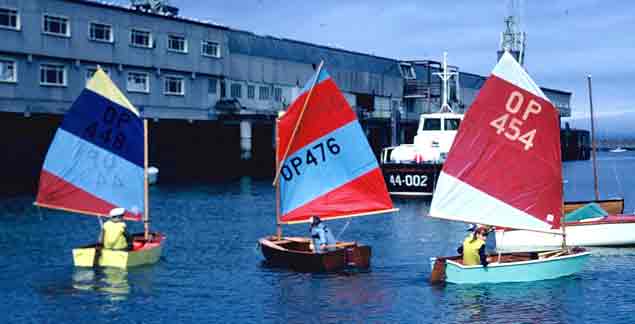 The first of the new fleet sails. Paddy Boyd (left) Ann Kirwan (centre) and Vivienne Lavery right) getting to know their boats
The first of the new fleet sails. Paddy Boyd (left) Ann Kirwan (centre) and Vivienne Lavery right) getting to know their boats
While Johnny Hooper had introduced the idea, he stood back from its continuing implementation, for the Hooper modus operandi was to give an idea enough strength to soon have wings of its own. That certainly happened in the National Yacht Club, for very quickly a manageably small committee was in being, and the formidable Carmel Winkelmann became its secretary. The NYC Junior Programme became her baby, and it always has since been seen as such, even though the number of people involved in administering the programme over the fifty years, as the NYC facilities have expanded and developed to meet the needs of a modern membership, will now run into the hundreds.
In fact, properly organized junior sailing with boats specifically designed for young people’s needs is now so central to Irish sailing that it takes a huge leap of the imagination to visualize the scene as the first small group of National Yacht Club Optimist Dinghies – most of them locally-built either by amateurs or professonals – began to emerge in May 1967 with numbers increasing as each weekend passed. New they may have been, but they reflected their era, with a public Blessing of the Boats outside the Brindley household as a new batch of boats appeared.
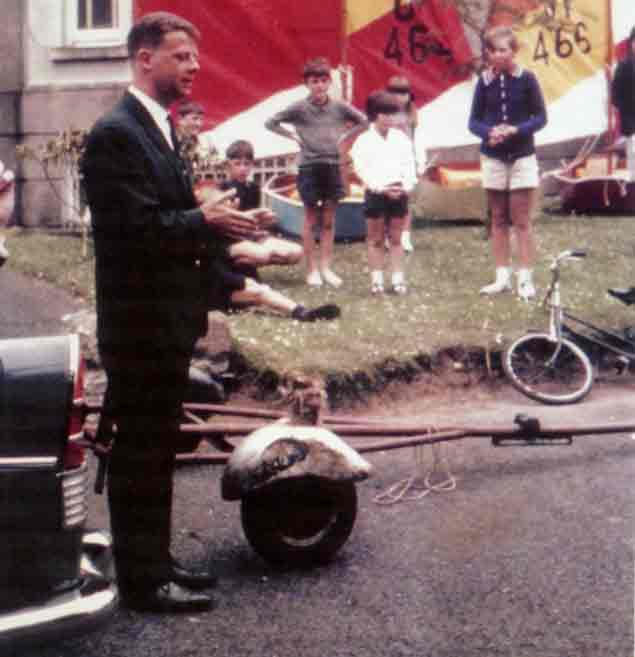 Olympic sailor Johnny Hooper speaking at the Blessing of the Boats as a new batch of home-built Optimists awaits transfer to the National’s limited space.
Olympic sailor Johnny Hooper speaking at the Blessing of the Boats as a new batch of home-built Optimists awaits transfer to the National’s limited space.
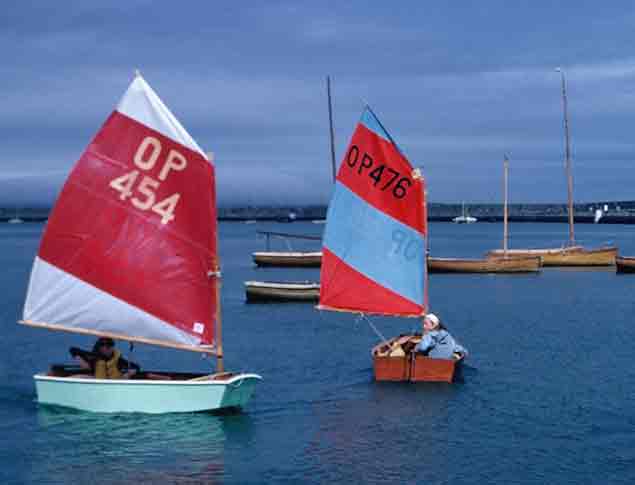 Dun Laoghaire was a different place in those days, with Water Wags and Mermaids expected to lie to mooring. Vivienne Lavery and Ann Kirwan testing their skills with the new Optimists – Ann’s boat (476) was one of the few professionally-built in the first batch of Optimists, she was created by the legendary Skee Gray
Dun Laoghaire was a different place in those days, with Water Wags and Mermaids expected to lie to mooring. Vivienne Lavery and Ann Kirwan testing their skills with the new Optimists – Ann’s boat (476) was one of the few professionally-built in the first batch of Optimists, she was created by the legendary Skee Gray
But though most young sailors in theory had his or her own boat, before anything approaching full fleet numbers was approached they’d a habit of letting anyone sail some boat or other in the early stages, so much so that although Ann Kirwan was part of it from a very early stage, she admits that even she can’t claim total accuracy when identifying the helm of a known boat.
 Going abroad......the new Dun Laoghaire Optimists make their debut at Bray Regatta: Paul, Adam and Lucy Winkelmann with Paddy Kirwan putting in his renowned act as a South American Air Marshall at Bray Sailing Club.
Going abroad......the new Dun Laoghaire Optimists make their debut at Bray Regatta: Paul, Adam and Lucy Winkelmann with Paddy Kirwan putting in his renowned act as a South American Air Marshall at Bray Sailing Club.
This habit of inter-changing sailors became even more marked in that first year when the early class discovered that the most useful base for their day-time sailing was the little-used Irish Lights service barge moored in the western part of the harbour. Over there, NYC Optimist sailors found much clearer sailing water, and they were well away from the comings and goings of the two cross-channel ferries off their home club, not to mention excessive parental control. In effect, the barge became their day-time base, and they ate their packed lunches aboard it while deciding who would take which boat for the first stage of the afternoon’s sailing. Fifty years down the line, we might well wonder if the Commissioners of Irish Lights are aware of the key role their humble barge played in launching Ireland’s Junior Training Programme.....
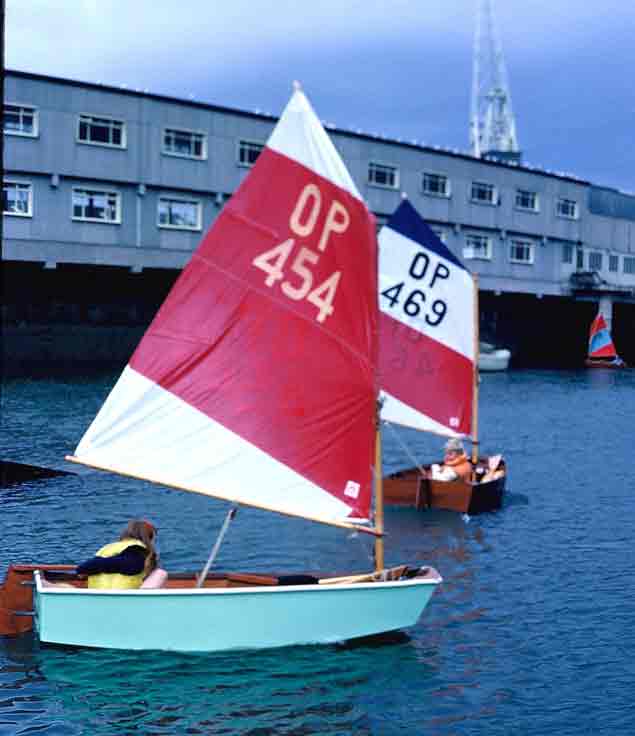 Vivienne Lavery and David Ryan getting away from the slip.
Vivienne Lavery and David Ryan getting away from the slip.
Once launched in its viable form in 1967, there was no stopping it, and the names which have emerged just from the National’s junior programme alone (for virtually all clubs now have one) take us over an extraordinary range, and up to the heights of Olympic participation, the winning of major world dinghy championships and associations with the America’s Cup.
It’s Johnny Smullen who provides the latter. The California-based Johnny Smullen in San Diego is now of world stature in anything to do with yacht and boat-building or indeed in marine construction generally, and his talent has been recognized at the highest level as he has worked on major projects for the very demanding Dennis Conner, aka Mr America’s Cup.
Johnny will have inherited his feeling for classics from his father Cass, a great sailor who was such an enthusiast for the Dublin Bay 21s in their original rather spectacular gaff-rigged form that when the class contemplated changing to a more easily-handled and convenient Bermudan rig in 1963, Cass claimed that he could easily rig a gaff-rigged DB 21 in 15 minutes flat. And that included setting the jackyard topsail to perfection. So he brought a DB 21 close into the clubhouse (as you could in those days), and in front of a drink-sipping crowd of observers on the verandah, he did the job within 15 minutes. But they still went ahead and converted to Bermudan rig.
Son Johnny meanwhile was enlisted in the NYC Junior Programme as soon as he reached he lower age limit, and when the 40th Anniversary was being celebrated back in 2007, he sent on his memoirs which well capture the flavour of it all:
San Diego, 17th May 2007
The way I saw it.
I am eight years old and my parents are wondering what to do with me for the summer, it went something like this: “Get him out from under our feet”. I was equally happy to stay at home and play in the back garden, invent stuff and dream up ways to frighten my sisters. Chasing them with worms was a good one.
I was enrolled in the adventure of my life.
At first I was lead to believe it was going to be a fun thing with the opportunity to meet new people and friends, maybe making me more sociable as I was quiet child in a world of my own. I bought into this and showed up for the first day. It was great, lots of people all different shapes and sizes, so there we were all sitting around playing with stuff and one-upping on how my father is better than yours, especially at snooker. The chatter fell silent when along came this very tall white-haired lady with an incredibly loud voice. It was at this point I became suspicious as I had just watched Paths of Glory and A Bridge Too Far, I had seen how the enemy rounded up people and put them in trucks and brought to places, unfriendly places.....
We arrived at Sandycove harbour where we were lined up on the pier. I though this was it, we were then forced to line up at the steps and walk down into the freezing water fully clothed and flail around, there were guards (instructors we were led to believe) everywhere, and just to make sure the torture was effective they made us hold our heads under water for 30 minutes, well 30 seconds, but it felt like minutes. Then we were all forced to walk back to the NYC where our fate was to be determined. Freezing and scared, I was cursing my family and wondering what I had done to them.
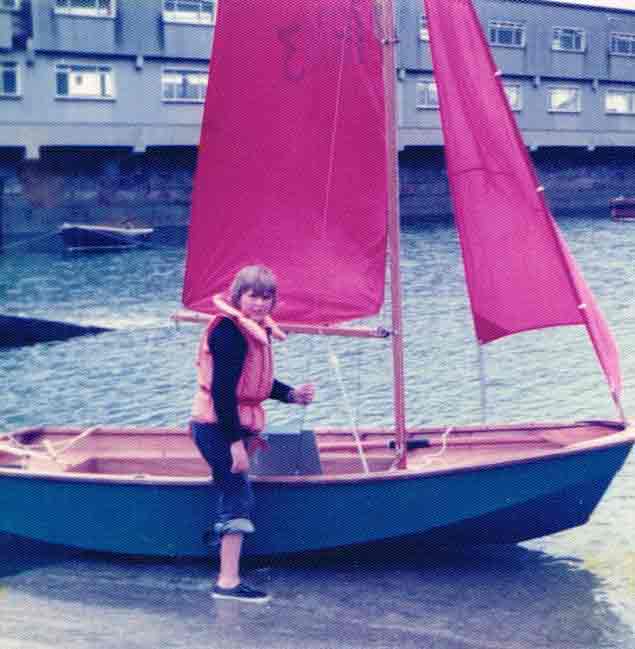 He survived.....eventually Johnny Smullen became a keen Mirror dinghy sailor, but he was pessimistic enough to call his boat Splinter
He survived.....eventually Johnny Smullen became a keen Mirror dinghy sailor, but he was pessimistic enough to call his boat Splinter
We arrived back at Camp NYC and were lined up and made to wear large cumbersome protective coats, some were yellow, purple, some orange, I guessed they were labelling us, something to do with our religion. Some of these jackets had large protective collars probably to help protect us from the beatings to come, I thought. Our names were branded onto the “Life Jackets” as I started to call them, knowing they would play a key role in our protection.
We were divided into groups and lead away by the guards into this large damp room with arches and a dank smell of cotton, hemp and mould. This was where we were to remain for all the rainy days to be brain-washed, they started by teaching us knots. I was convinced this was going to be how to tie the very knot that would be the doom of us, I compared it to carrying the cross of Calvary. I decided then to be really bad at it in the hopes that one of my knots would slip open and I could dash to my freedom. We also had to jump up, and hand-over-hand along the light blue steel beam that ran across the dark room, this was to make our arms really strong, they had a plan for strong arms – I will tell you about that a little later.
Food consisted of a march up to Wimpeys for a spice burger and chips all drowned in vinegar to disguise the taste, if there was good behaviour we got to go to the Miami Café. The day was long (except Thursdays when we had to get out early) and after a week in Boot Camp we were all tired and weary. What had I done to my family to deserve this?
The second week came along and we were introduced to the ships, rather large wooden craft resembling a landing craft with the flat bow (I was always looking for the hinges). This is where the strong arms came into. We were grouped into six per team, and the guards waited until low tide when we had to carry the ship down a rickety wooden slip (there’s a reason for calling it a slip). Upon its surface there were large wooden rollers but we were forbidden to use those rollers, and to make sure they filed a fat spot on the rollers, deeming them useless. We picked up the incredible heavy boat, all six of us, one on each corner holding a knee, and two in the middle by the oar locks. Later I was to learn the place to be was up at the bow (by the door), it was lightest. I was adapting to this cruel camp. As we descended down to the icy water again fully clothed, we came across a bright green pungent slime. I had what I thought were special sailing shoes, but as soon as I touched the slime I was down. Down hard. The guards started yelling, I knew I had to get up quickly....remember Calvary!....We reached the bottom and stopped, the guards yelled again and made us wade right into the icy deep, still fully clothed. With the landing craft now floating, we had to master manoeuvring, the craft were lined up alongside the slippy slip, that’s the reason they call it a..................
I stepped on the gunwhale. Now at this point I did not understand the physics like I do today, and when you apply a load to any point of the gunwhale of a flat-bottomed craft two things will happen (once only). The opposing gunwhale will come up as you travel down, and because I am as tall as the craft is wide, somewhere in the middle he two surfaces will meet, your face and the opposing gunwhale. After the initial shock, the second shock comes from the icy cold water. Then I found out what the large collar was for as the guards hauled me out of the abyss semi-conscious. Once inside the craft, we were grouped into two and handed oars. Let the games begin.....
After a week of rowing and shipping oars and coming alongside we were all adapting well to boating, there’s nothing to it. Just as we are enjoying ourselves, we are reminded that this is a work camp with launch and retrieval exercise twice a day. The launch and retrieval is carefully timed at 6 and 12 hours intervals to make sure it was low tide and we’d the longest slimiest walk up the rickety slips, observed closely by the guards from the window of the snooker room glaring down at us. Boating is turning out to be challenging but fun, and the new friends are all pitching together to eventually plan an assault on the guards to free ourselves.
The third week came along and there were large wooden poles with white canvas and a stick with notches cut out of it, why on earth did they have to make it harder? It was perfectly simple with the clean decks and oars and oar locks, now the boats are so heavy with this rig up, my bow lifting position is not that smart as we carry down the slip with the sail pressed hard against my face. After countless days of theory brainwashing in the damp room, we have to pass a few tests to prove worthy to sail, if called upon, out to the US Aircraft Carrier John F Kennedy anchored out in Dublin Bay. The first test was to take the stick with the notches and stretch out the canvas and hook onto a rope loop, without falling over this was harder than carrying the feckin’ boat, the second was to line up two pins while hanging over the transom full of chips and spice burgers. If it had hair....
Most of us mastered that task after a few tries, and it wasn’t long before we were sailing out to the sterns of the ferry Hibernia or Cambria, whichever was in port at the time. This went on for a few weeks and as we settled into the routine it got easier as we went on.
During the time in the damp boathouse, usually when it was blowing dogs off chains outside and while I was trying to get the batteries out of the loudhailer, I noticed a beautiful varnished clinker planked boat, it was almost new, and a very wise man was looking after it. This Man was tough as the rivets holding it together and knew everything about the seas. I knew if I paid attention he would help get me through the summer, he did and he is almost responsible for what I do today. Thank you Jack!
The discipline of Boot Camp had turned us into great sailors, great card players, snooker players....it wasn’t until the third stage we found flagons. But not on the night of May 17th 1975, I was at home doing my homework that night....
Ah.....the memories, I hope I have stirred a few, it was the most wonderful time of my life and I wish I was there to get drunk with all of you and play cards till the wee hours, but meanwhile thanks
To Carmel, thank you very much; I always have my lifejacket.
To Jack Brennan, I am always thinking of you up there, and thanks for teaching me how to tie my shoelaces.
To all the instructors Paul, Ann, Jimmy, I never believed the story of the rabbit and the tree, but thanks anyway
And to all my dear family and friends
Lots of love, Johnny Smullen
PS It was me that stuck the coke bottle in the cannon at the front of the club....
 Johnny Smullen and Dennis Conner inspect the hull of the 1925-built Cotton Blossom
Johnny Smullen and Dennis Conner inspect the hull of the 1925-built Cotton Blossom
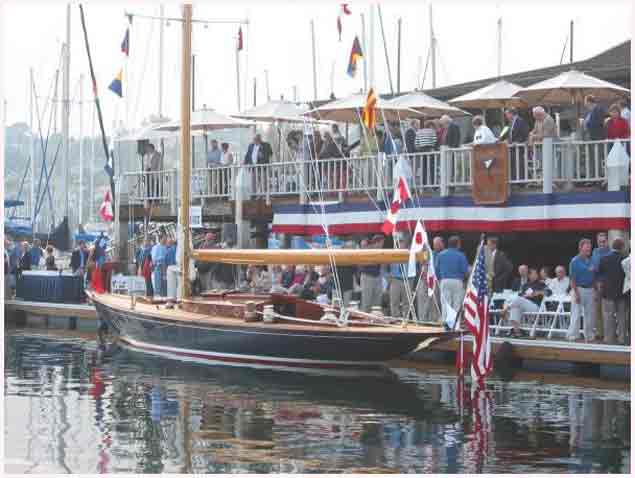 Cotton Blossom II after restoration by Johnny Smullen
Cotton Blossom II after restoration by Johnny Smullen
Inspired by Jack Brennan and other master craftsmen, Johnny has gone on to become a shipwright of such skill from his base in San Diego, California, that he in turn inspires others, one of his most famous projects being the complete restoration of the 49ft Q Class sloop Cotton Blossom II of 1925 vintage.
When a complete restoration is contemplated, Johnny doesn’t mess about. The word is that when he and Dennis turned up to finalise the deal on Cotton Blossom and bring her back to San Diego, they found the previous owners sorry enough to see her go, and rather proud of the style in which they’d maintained her. But after they’d gone to sort the details with the new owner, they went to take a last look at the boat. It’s said they found that Johnny had already delivered his opinion on the existing rig by cutting the shrouds and stays at the deck with bolt-croppers, and cutting the old mast off at deck level with a chainsaw.
Maybe that’s an apocryphal Johnny Smullen from taking delivery of another boat. Yet when you see Cotton Blossom in her restored form, it’s clear what Johnny says should indeed be Holy Writ. This is a project of world standard. But what’s even more remarkable is that despite everything the Sailing Boot Camp at the NYC might have inflicted on him all those year ago, Johnny’s love of boats and sailing is such that he has his own personal sweet classic, the lovely 36ft International One Design Altair. She’s sailed as often as possible, and though he can’t make it back to Dun Laoghaire next month for the Golden Jubilee as there’s very major project under way, Altair will be racing with the San Diego classics under the National Yacht Club burgee.
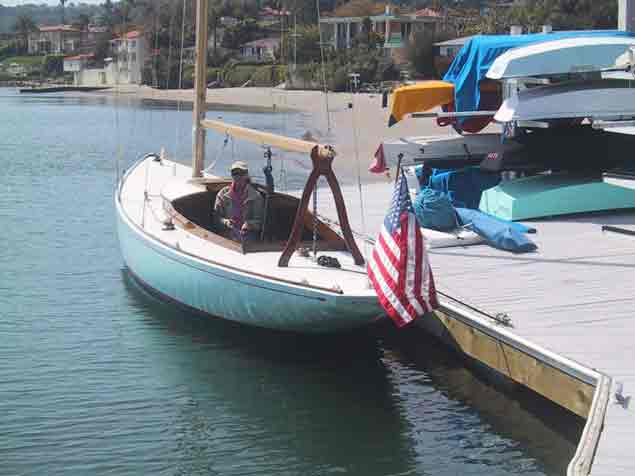 Johnny Smullen’s own pet boat Altair reveals his abiding love of sailing.
Johnny Smullen’s own pet boat Altair reveals his abiding love of sailing.
John Lavery’s father Arthur was another of those pioneering Optimist dads back in the late 1960s, and John and his sister Vivienne were both in that first batch of trainee sailors. He ended up winning championships in more classes then you could quickly count, but the peak of it all came in September 1995 when he and David O’Brien of this parish won the Fireball Worlds in Dublin Bay.
In fact, the graduates from 50 years of a junior training programme at the National YC can be found in successful positions in many boat classes in many places, but it is the club’s outgoing attitude to those who wish to learn to sail which deservedly provided its most outstanding success. A long time ago a Mrs MacAleavey, a widow with no sailing connections, was looking for a club which would make her increasingly boat-mad daughter Cathy – who had recently bought a clapped-out 420 – feel encouraged in any way to learn to sail. Despite the fact that it was still in process of recovering from a fire in the clubhouse, the NYC showed itself the most welcoming along the Dun Laoghaire waterfront, so much so that Mrs McAleavey felt sufficiently encouraged to buy her daughter a new 420, and that in turn led on eventually to Cathy representing Ireland in the women’s 470 in the 1988 Olympics.
The three children she had with husband Con Murphy went on to get their introduction to sailing through the National YC’s junior programme, and daughter Annalise emerged with the talent and the burning ambition which resulted in a heart-breaking fourth at the 2012 Olympics in the Women’s Laser Radial when a medal had seemid almost certainly within her grasp. But memories of that were entirely laid to rest with the Silver Medal in the 2016 Olympics Rio after a difficult final race in which the lone sailor seemed to stay as cool as you please, while the nation at home watched with bated breath.
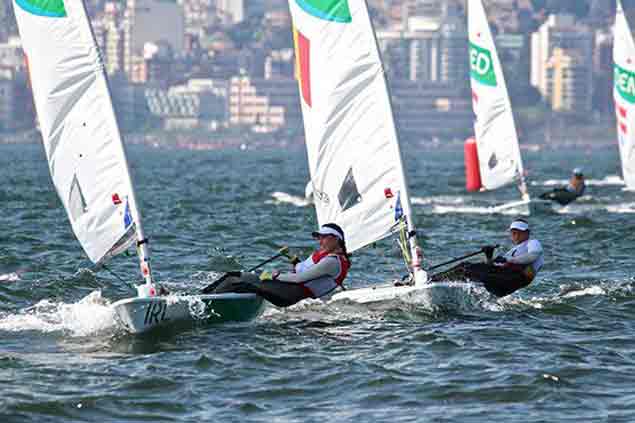 The medal-winning moment as Annalise Murphy crosses the finish line in Rio to win Silver.
The medal-winning moment as Annalise Murphy crosses the finish line in Rio to win Silver.
That it was ultimately a very personal achievement is something respected by her club, and they claim to have done nothing more than provide the first steps on the pathway, and a general spirit of encouragement. But nevertheless the success is all of a piece with the Golden Jubilee which will be celebrated on May 20th, and Carmel Winkelmann continues in her mission of providing a background of training for young sailors of all types, whether they aim only to be a competitive club sailor, or whether they aim for the ultimate heights.
Thus one of her projects in recent years was to find real support for young Finn Lynch, who had reached that difficult stage of being a top junior sailor, yet still had to find his feet as an adult. Thanks to support raised by Carmel, he became Ireland’s representative in the Men’s Lasers at Rio despite going through the final stages of the selection with a training injury recovery problem which may have had an adverse effect on his performance in as the youngest sailor in Rio, aged just 20.
Whether or not he would have been better off not being in Rio at all is neither here nor there. When you’re 20, four years can seem an appallingly long time. The Tokyo Olympics in 2020 must have seeemed aeons away for a young sailor who had shown many flashes of real talent. It was better for him to be in Rio while learning a lot, rather than kicking his heels in frustration in some dead end. And when he needed material help to see through the campaign, it was Carmel Winkelmann who was there to make to ensure that support was available. That will be something else for celebration on May 20th.
 Carmel Winkelmann and Finn Lynch at the National Yacht Club, June 2016. Photo W M Nixon
Carmel Winkelmann and Finn Lynch at the National Yacht Club, June 2016. Photo W M Nixon
Olympic silver medallist, Annalise Murphy, visited a number of schools in Dún Laoghaire-Rathdown yesterday, with An Cathaoirleach of dlr, Cllr Cormac Devlin. Annalise visited the schools to showcase the opportunities to learn sailing along our beautiful coastline.
Following the visits to the five schools, an Cathaoirleach of dlr, Cllr Cormac Devlin, said, “I was proud to travel from school to school across the County with Annalise Murphy. Her achievements, and most of all her message to young people, is one that encourages them to dream big and not fear failure. She is a wonderful ambassador not only for sailing but for sport generally. I commend the Irish Sailing Association and dlr for partnering together on this initiative'
'As a coastal County we must all work to promote sailing to the next generation so that the public utilise our waterfront more. The children we met look up to Annalise and we all look forward to her continued success', Cllr Devlin added.
The visits were organised by the dlr Sports Partnership and the Irish Sailing Association.
National Yacht Club Achievements in 2016 Include Cruising, Offshore, One Design & Dinghy Sailing Success
Dun Laoghaire's National Yacht Club gathered on Saturday to salute top club achievements from 2016. Ten annual awards for outstanding sailing were presented ranging from cruising endeavours to Olympic campaigns. There is no surprise that club member Annalise Murphy topped the awards with her Olympic Silver Medal being the defining moment of the Irish sailing year.
In cruising, The Township Cup went to Jim Gorman for his cruise to Norway. Marcus Higgins was awarded The Muglins Cup for his adventurous cruise on his Vega 27 thorugh the Canal du Midi to Sardinia.
In the offshore racing category, Brian and John Hall were awarded the Boyne Regatta Cup for their victory in the Scottish Series.
In one design racing, The O'Leary Cup went to Mick Leahy and John Power for their performance in the Beneteau 31.7 Levante in both DBSC and regattas in 2016.
View a slide show of the 2016 recipients by Joe Fallon below:
The Dublin St Patrick’s Day Parade has become such a colourful extravaganza that having an Olympic Sailing Silver Medallist as Grand Marshall is something which a almost got lost in the crowd. But Irish sailing’s own Annalise Murphy, heroine of Rio, bravely stepped up to the plate to lead the way in a classic vintage car, accompanied by her mother Cathy, herself a former Olympian sailor. They gallantly saw it through in style, and our photo shows Annalise with some of her newfound fellow Paraders having a quick visit to Liffeyside, which maybe wasn’t quite the same as Rio de Janeiro in regatta mode, but the mood was good.
Annalise Murphy To Lead Dublin St Patrick’s Day Parade
#AnnaliseMurphy - Annalise Murphy can add the honour of grand marshalling this year’s St Patrick’s Day Parade in Dublin to her list of accolades, as The Irish Times reports.
“I’ve spent so many Patrick’s Days away or competing or training, so it’s going to be brilliant just to be at home in Dublin,” said Afloat’s Irish Sailor of the Year for 2016 at the launch of this year’s St Patrick’s Festival, which runs from 16-19 March.
According to festival chief executive Susan Kirby, the Olympic Laser silver medallist was chosen to lead the parade as “she very much personifies the best of Ireland on a global stage and she certainly flew the flag for us all in Rio.”
The Irish Times has more on the story HERE.
Sailor of the Year Annalise Murphy Leads the Charge for Moth Womens' World Championship Honours
Afloat.ie's Sailor of the Year, Annalise Murphy, the 2016 Laser Radial Olympic Silver Medallist and 2014 Women's Moth World Champion, leads the charge in the growing women's fleet of this year's Moth World Championships scheduled for Malcesine, Italy.
Murphy's Rio performance was rewarded at home last Friday in a packed gathering at the RDS, Dublin. See photos and report here.
Murphy will be up against reigning champion Wakako Tabata (JPN) and 2013 Women's Champion Emma Gravare (SWE). With 6 months remaining, the 2017 Moth Worlds has already attracted a record number of entrants. Earlybird entries closed on Tuesday with 190 competitors from 25 countries registered for the event to be held at the Fraglia vela Malcesine on Lake Garda in late July.
The record line–up features a daunting who's who of top sailors.
At the top of the list is the Olympic Laser shoot out, with reigning Moth World Champion, 2008 Gold Medallist and Artemis Racing helmsman Paul Goodison (GBR) going up against 2012 Gold Medallist and Oracle Team USA tactician Tom Slingsby (AUS) and 2016 Gold Medallist Tom Burton (AUS).
Among the past champions, 2009 & 2013 Moth World Champion Bora Gulari (USA) makes a comeback to the class after taking time out to compete in the Nacra 17 at the Rio Olympics. Also making a return after Olympic and Americas Cup commitments, dual medallist Iain Jensen (AUS) will be looking to improve on his top 10 result in 2015.
All Ireland Gets Together for Sailing Celebration (Photo Gallery of the Sailor of the Year Awards Here)
In public perception terms, sailing had never been higher on the scale of national interest in Ireland than it was in August 2016 when Annalise Murphy’s Olympic Silver Medal victory had an entire nation and its widespread diaspora on the edge of their seats as the final seconds were sailed out in the Medals Race at Rio writes W M Nixon.
But popular attention is a very fickle thing which has now turned to other matters. And with Annalise Murphy since being garlanded with well-earned major national awards under just about every category you could think of, there wasn’t undue concern that the biggest non-surprise for a long time – her elevation to become the Volvo Sailor of the Year 2016 – would simply be taken for granted, and as such, would be regarded as non-news by mainstream media.
So whether it was a mature acceptance of this reality by sailing’s organizers, or whether or not it was just pure serendipity, is neither here nor there. But the fact is that holding the awards ceremony on the last Friday night of January in Dublin may have been the sentence of death of terms of popular news coverage. But for the true faithful of the sailing community from every last corner of Ireland, it was the perfect opportunity for an extraordinarily diverse crowd of people to gather and celebrate their sport in all its forms, and hail their heroes.
Of course the ultimate spotlights were on our supreme award winner Annalise Murphy, and the Youth Sailor of the Year Ewan MacMahon. But with other youth awards, training centre awards, and the very elastically-interpreted Afloat.ie “Sailor of the Month” awards with 27 winners coming into focus, that same spotlight shone brightly if briefly on remarkable achievements in every part of Ireland and abroad, all of them contributing to the fabulous tapestry which is Ireland’s world of boats.
Normally the world of boats and sailing is well aware that it is a minority sport. But on Friday night, it wasn’t a case of it briefly becoming a majority sport. It was the only sport. The camaraderie was palpable. The shared enthusiasm was energising. And the way that people from near and far instantly connected was heartening to behold.
For me, it was summed up by one brief but eloquent encounter. I was talking with Ted Crosbie, who was Admiral of the Royal Cork in 1984-86, and long before that he was the All Ireland Helmsmans Champion, racing in IDRA 14s in 1950. He was there to see his grand-daughter Sophie receive proper recognition for her achievements in Topper racing. As we chatted, Peter Ryan of the National YC hove into view with his shipmate Stephen Tudor of Pwllheli in North Wales, whose overall victory in the ISORA Championship 2016 with his J/109 made him Afloat.ie “Sailor of the Month” for September.
The fact that a top Welsh skipper should win an Irish Sailor of the Month award says all that needs to be said about the creative flexibility of the Afloat system. But equally, here were two top sailors from very different places and backgrounds and generations instantly hitting it off in their shared joy in our sport. The divine spark was undoubtedly present. It was that kind of night.




























